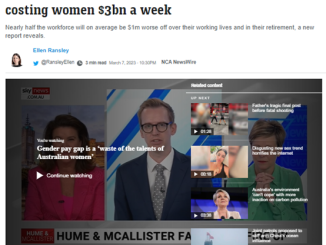
Video source:Vox, Youtube
As an issue that has been necessitated and talked about on multiple forums, be it online or offline, gender pay gap is an issue that needs our immediate attention.
The news while interesting is still one of the lesser talked about issues in terms of women’s rights and issues that are discussed.
When people talk about the gender pay gap, the statistic they often hear is, “For every dollar men earn, women earn 79 cents.” Maud Zhang, a gender studies student at the University of Melbourne, said the gender pay gap was real.
Largely because women have been excluded from public and political life not only in the Australian society but it is a problem that is persisting worldwide.
In terms of the Australian context, as an example, we can take the case of how it was not until 1943 that women were considered to be eligible enough to be elected to the Common Wealth Parliament.
The gender pay gap in public sector jobs in Australia has rose to about 14.1 % in the last year.
These figures prove to be quite dramatic in the sense that although women are contributors towards the annual GDP of a country, the ratio of pay gaps between men and women contribute to the decline of the economy.
This problem with the iteration of the pay gap between men and women is that it is a matter that the economy of a country is contingent upon. Although there exists a huge pay gap between the genders, the problem does not remain confined to one geographical area.
The problem of gender pay disparity even exists in countries such as USA, UK, China, Japan, and many other European countries with varying ratios.

Photo source: Unsplash
Accountability remains one of the major factors through which this problem can be tackled. Different professional fields report difference in the pay disparity, some fields more than the others.
It is interesting to note that, the professional fields that are considered to be predominantly male dominated has a higher percentage of pay disparity between the genders.
Although Australia’s gender pay disparity is one of the narrowest on record, it has still been proven that women earn less than men in every industry.
This gap percentage however varies with respect to different industries and work sectors. For instance: community workers are predominantly underpaid as women are more drawn to this particular career opportunity.
In direct opposition to that, it has been found that there is a dearth in the number of women occupying high level positions in certain industries that have a notion of being ‘male dominated’.
While interviewing a few nurse that have worked through the pandemic and are still functioning through the staff storage, it has been noticed that although the discrepancies have narrowed basically over the years, it still is large enough for it to be considered a problem that is affecting women in the nursing sector.
After interviewing Kexue Zhou, an associate professor of gender and cultural studies at Fudan University, it was noted that “the pay gap exists as a postmodern form of patriarchy that puts the onus on women to break the mold and make a name for themselves in the professional world.”
“In the education sector, it has been noted that men hold more tenured positions than women and that research done by men receives more attention than research done by women.”The Covid-19 pandemic, has contributed to the pay disparity that exists in the highly competitive STEM field.
According to a report published by the Workplace Gender Equality Agency, women are paid on an average $26,000 less than men in any given sector.
The data which is based on over 4 million employees across Australia, justifies that fact that it is a problem that has been persisting for a very long time and in turn has an effect on the economic outcome of the country as well.
However, in order to set forth a move of transparency and to set a good precedent, The Workplace Gender Equality Amendment Bill 2023, has been introduced that is set to close the gender pay gap that currently exists.
The bill requires companies and different workforces to publish their data on their websites that will help create a more streamlined process that will advocate for more equality in terms of wages for both male and female workers.
According to an interview with Dr. Xiyan Chen, a scholar at Zhejiang University, she further added that compared with men, “it takes women much longer to obtain tenured positions in prestigious universities, which has nothing to do with their respective skill sets.”

Photo source: Pexels
In other words, it can be said that gender pay gap is something that is a by product of inherent patriarchal practices in our society and in the current context, more and more economies are adopting plans that will help tackle such issues and create a more level field for people starting out in any given profession.
Following suit in the manner of these economies it can therefore be concluded that substantially closing the gender pay divide leads to a greater economic outcome and improves the working conditions of various professional sectors as well.
About the Author
Bachelor of Business, majoring in Management, James Cook University.
Master of Media Practice, the University of Sydney.




Be the first to comment